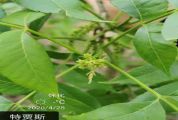 PDF(3342 KB)
PDF(3342 KB)


湖南低山丘陵区薄壳山核桃的开花物候期观测及品种配置
蒋瑶, 魏海林, 高昌虎, 王大故, 冯楠可, 李睿, 刘榕榕, 吕芳德
南京林业大学学报(自然科学版) ›› 2021, Vol. 45 ›› Issue (1) : 53-62.
 PDF(3342 KB)
PDF(3342 KB)
 PDF(3342 KB)
PDF(3342 KB)
湖南低山丘陵区薄壳山核桃的开花物候期观测及品种配置
Observation on flowering phenology and variety combination of Carya illinoinensis in low mountains and hills of Hunan Province
 ,
,
【目的】观察湖南地区14个薄壳山核桃品种的花发育特征和开花物候期,确定适宜的品种配置。【方法】以湖南省怀化市树龄为7 a的薄壳山核桃14个品种为材料,观察群体及单花(雌、雄花)开花时间、花发育形态以及散粉期和可授期,记录并分析花发育时期气候条件。【结果】14个品种的薄壳山核桃中有4个品种为雌先型,5个品种为雄先型,5个品种为同熟型。雌花一般在4月下旬进入现蕾期,5月中旬进入可授期,雄花在4月下旬和5月上旬进入萌芽伸长期,5月中上旬进入散粉盛期,由此得出该地区‘密西西比’、‘亚林100’、‘威奇塔’、‘斯图尔特’和‘卡多’4个品种具有一定的自花授粉能力,适宜的授粉组合为‘湘林1号’ב福克特’,‘密西西比’ב卡多’,‘金奥瓦’ב特贾斯’、‘金奥瓦’ב斯图尔特’或‘金奥瓦’ב马汉’,‘佩鲁奎’ב特贾斯’、‘佩鲁奎’ב马汉’或‘佩鲁奎’ב斯图尔特’,‘波尼’ב特贾斯’或‘波尼’ב马汉’,‘普兹内’ב特贾斯’或‘普兹内’ב马汉’。【结论】不同品种薄壳山核桃的开花物候期是建立果园的重要依据之一,本试验结果可为湖南及中南低山丘陵区薄壳山核桃的品种配置提供参考。
【Objective】 The purpose of this study was to observe the flower development characteristics and flowering phenology of 14 Carya illinoinensis in Hunan Province, and to determine a suitable variety of combinations. 【Method】 Taking 7-year-old C. illinoinensis in Huaihua City, Hunan Province as materials, the flowering time, flower development morphology, pollen dispersal period and receptive period of female and male flowers were observed, and the climatic conditions of the flower development period were recorded and analyzed. 【Result】 Among the 14 varieties of C. illinoinensis, four varieties were protogynous, five varieties were protandrous, and five varieties were monochogamous. Female flowers generally entered the budding period in late April and entered the receptive period in mid-May. The male flowers entered the elongation period in late April and early May and entered the pollinating period in early to mid-May. It was concluded that ‘Mississippi’, ‘YaLin No. 100’, ‘Wichita’, ‘Stuart’ and ‘Caddo’ had a self-pollination ability in this region, and the suitable variety combinations were ‘XiangLin No. 1’ × ‘Forket’; ‘Mississippi’ × Caddo’; ‘Kiowa’ × ‘Tejas’, ‘Kiowa’ × ‘Stuart’ or ‘Kiowa’ × ‘Mahan’; ‘Pyzner’ × ‘Tejas’, ‘Pyzner’ × ‘Mahan’ or ‘Pyzner’ × ‘Stuart’; ‘Pawnee’ × ‘Tejas’ or ‘ Pawnee’ × ‘Mahan’; ‘Pyzner’ × ‘Tejas’ or ‘Pyzner’ × ‘Mahan’. 【Conclusion】 The flowering phenology of different varieties of C. illinoinensis is an important basis for establishing orchards. The results of this experiment provide a reference for the variety combinations of C. illinoinensis in Hunan and the hilly areas of central and southern China.

薄壳山核桃 / 花发育特征 / 开花物候期 / 品种配置 / 湖南省
Carya illinoinensis (Wangenh.) K. Koch / flower development characteristics / flowering phenology / variety combination / Hunan Province
| [1] |
贾晓东, 王涛, 张计育, 等. 美国山核桃的研究进展[J]. 中国农学通报, 2012,28(4):74-78.
|
| [2] |
许梦洋, 贾晓东, 罗会婷, 等. 6个薄壳山核桃品种的果实发育过程及果实结构和性状变化[J]. 植物资源与环境学报, 2020,29(2):46-54.
|
| [3] |
|
| [4] |
谢静. 薄壳山核桃开花生物学特性研究[D]. 南京:南京林业大学, 2013.
|
| [5] |
陈芬, 姚小华, 高焕章, 等. 薄壳山核桃不同无性系开花物候特性观测和比较[J]. 林业科学研究, 2015,28(2):209-216.
|
| [6] |
张瑞, 李晖, 彭方仁, 等. 薄壳山核桃开花特征与可授性研究[J]. 南京林业大学学报(自然科学版), 2014,38(3):50-54.
|
| [7] |
陈勤, 董润泉. 美国山核桃开花习性及授粉品种搭配[J]. 云南林业, 2017,38(2):66.
|
| [8] |
房瑶瑶, 陈兴彬, 杨克强. 核桃实生群体物候的观测[J]. 经济林研究, 2011,29(3):97-101.
|
| [9] |
莫正海, 张计育, 翟敏, 等. 薄壳山核桃在南京的开花物候期观察和比较[J]. 植物资源与环境学报, 2013,22(1):57-62.
|
| [10] |
郭红艳, 王森, 钟秋平, 等. 华中五味子开花物候期与花部形态特征研究[J]. 经济林研究, 2017,35(4):155-163.
|
| [11] |
刘雨, 常君, 任华东, 等. 薄壳山核桃雌花发育的解剖学研究[J]. 西南大学学报(自然科学版), 2018,40(6):32-37.
|
| [12] |
BACKGROUND: Philodendron is the second largest genus of Araceae, being highly diverse in the Atlantic Forest biome, with nearly one third of the Brazilian species occurring in Southern Brazil, particularly in Rio de Janeiro state. During a local inventory in Silva Jardim municipality, we found a peculiar population of Philodendron growing in lowland rainforest. RESULTS: After morphological analysis and comparisons with similar species, the population proved to be a new undescribed species of subgenus Philodendron section Macrobelium. CONCLUSIONS: The new species, named Philodendron luisae, is here described, illustrated and compared to morphologically close species.
|
| [13] |
李虹, 王徐彤, 林清火, 等. 基于生长期和累积生长度日的龙眼果树催花法[J]. 热带作物学报, 2015,36(2):244-251.
|
| [14] |
刘海蓉, 谢伦胜, 谷玉东, 等. 新疆温宿核桃生长关键期气象指标及气象灾害影响[J]. 沙漠与绿洲气象, 2019,13(3):131-136.
|
| [15] |
周祎鸣, 张莹, 田晓华, 等. 基于积温的文冠果开花物候期预测模型的构建[J]. 北京林业大学学报, 2019,41(6):62-74.
|
| [16] |
|
| [17] |
田爱梅, 吴国良, 刘群龙, 等. 美国山核桃及其主要品种的特性[J]. 落叶果树, 2002,34(6):59-60.
|
| [18] |
|
| [19] |
|
| [20] |
|
| [21] |
|
| [22] |
谢静, 彭方仁, 韩明慧, 等. 不同品种薄壳山核桃花期特性研究[J]. 江苏林业科技, 2013,40(2):18-22.
|
| [23] |
张嘉伟. 不同地区长山核桃品种开花习性与经济性状比较研究[D]. 长沙:中南林业科技大学, 2019.
|
| [24] |
杨建华, 习学良, 范志远, 等. 不同美国山核桃品种的发芽及开花习性研究[J]. 西部林业科学, 2008,37(1):86-90.
|
| [25] |
魏芸楚, 曹凡, 窦全琴, 等. 薄壳山核桃12个品种的种子形态及发芽特性比较[J]. 江苏林业科技, 2019,46(6):7-12.
|
| [26] |
梁珊珊. 湘西北核桃资源及良种选择研究[D]. 长沙:中南林业科技大学, 2015.
|
| [27] |
施亚晨. 美国山核桃雌雄异熟性初步研究[D]. 南京:南京林业大学, 2015.
|
| [28] |
刘慧敏, 敖书飞, 乌云塔娜. ‘湘林’系列油茶授粉品种配置模式研究[J]. 中南林业科技大学学报, 2016,36(4):17-24.
|
| [29] |
梁珊珊, 吕芳德, 蒋瑶, 等. 美国山核桃坚果主成分分析及综合评价[J]. 中国南方果树, 2015,44(3):123-128.
|
| [30] |
许梦洋, 贾晓东, 罗会婷, 等. 6个薄壳山核桃品种的果实发育过程及果实结构和性状变化[J]. 植物资源与环境学报, 2020,29(2):46-54.
|
/
| 〈 |
|
〉 |